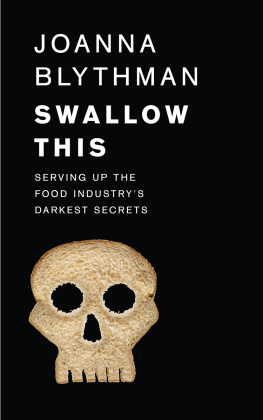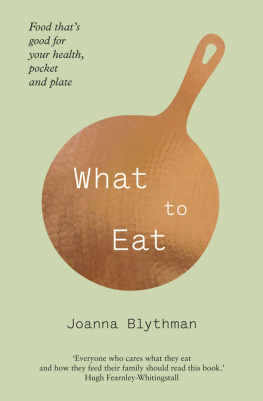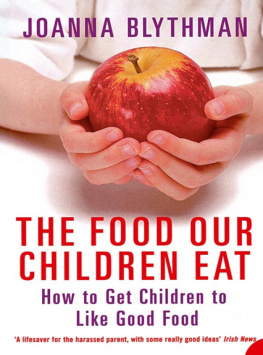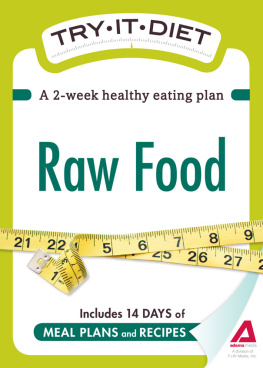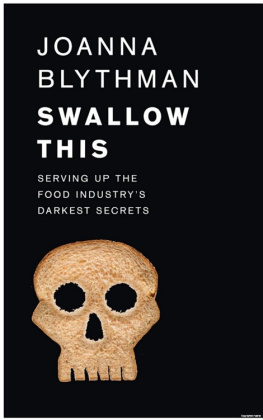a fellow foot soldier in the food wars.
Journalists dont like to be palmed off with half the story, but even though I had 25 years of food chain investigations under my belt, six books to my name, and a collection of awards and gongs on my trophy shelf, I had a sneaking suspicion that this was exactly what was happening. Unanswered, or only partially answered, questions about the food we consume each day nagged away at the back of my mind. How natural is the process for making a natural flavouring? What, exactly, is modified starch, and why is this ingredient in so many foods? What is done to pitta bread to make it stay fresh for six months? Why, when I eat a supermarket salad, does the taste linger in my mouth for several hours after? Slowly but surely, I realised just how little information about food production methods is in the public realm, despite the best efforts of those of us who interrogate the inner workings of the industry.
Now this assessment might seem counterintuitive, after all, you would be right in thinking that food exposs are a staple ingredient in news headlines. The media attention lavished on food fraud in particular is not inconsiderable. Thanks to such revelations, we know, for example, that crooks have illegally fed a stream of horsemeat into some of our most popular processed meats. We suspect, with some justification, that such incidents are only the tip of an iceberg.
But my frustration, my sense of not quite getting to the bottom of the story, was more fundamental. Forget illegal activities in the food chain, what about the perfectly legal activities that go on every day behind the scenes? What do we know about them? Im not talking about primary food producers, farmers and growers; what happens down on the farm and out in the fields. This link in our food chain is passably well policed and transparent. Nor am I talking about the abattoir where, once again, there are regular inspections, even the occasional undercover reporter from a vigilant animal welfare group, armed with a video camera. No, my growing preoccupation was just how pathetically little we really knew about processed food, the food that sits on supermarket shelves in boxes, cartons and bottles, everything that comes wrapped or packed in some way, food that has had something done to it to make it more convenient and ready-to-eat.
My interest was in not just the most clearly processed, most industrialised offerings, things like ready meals, chicken nuggets, oven chips and tinned soups, but also those that less obviously bear the stamp of the food factory: washed salads, smoothies, yogurt, cheese, cereal bars, butchered meat, fresh fish, bread, fruit juice, prepared vegetables, and so on. Many switched-on consumers try to avoid the former, but you would need to be a desert island hermit to steer clear of the latter.
Slowly but surely, factory-made food has come to occupy an ever more bloated position in our diet. You might find it all too easy to resist the lure of a turkey drummer, a ready meal, a lurid fruit drink, or a pappy loaf of standard white bread. You might even boycott the most obvious forms of nutritionally compromised, blatantly degraded offerings, and yet you will still find it hard to avoid the 6,000 food additives flavourings, glazing agents, improvers, anti-caking agents, solvents, preservatives, colourings, acids, emulsifiers, releasing agents, antioxidants, thickeners, bleaching agents, sweeteners, chelators and the undisclosed processing aids, that are routinely employed behind the scenes of contemporary food manufacture. That upmarket cured ham and salami, that artisan sourdough loaf, that seemingly authentic Levantine halva, that traditional extra mature, vintage Cheddar cheese, those supposedly health-promoting, rustic-looking breakfast cereals, those luxurious Belgian chocolates, those speciality coffees and miraculous probiotic drinks, those virginal yogurts that seem as pure as driven snow, those apparently inoffensive bottles of cooking oil, and much, much more may all have had a more intimate relationship with state-of-the-art food manufacture technology than we appreciate.
The curious thing about processed foods, be they of the crude type or the more sophisticated sort, is that their mode of production is an enigma. Of course, anything that comes in a box, tin, bag, carton or bottle has to bear a label listing its contents, and many of us have become experts at reading these labels to avoid ingredients with unnatural-sounding chemical connotations. But guess what? Many of the additives and ingredients that once jumped out at us from labels as flagging up something fake and unfathomable have quietly disappeared from listings.
Does this mean that their contents have improved? Possibly, but there is an alternative explanation. Over the last few years, many food companies have embarked on an operation dubbed clean label, with the goal of removing the most glaring industrial ingredients and additives from labels, replacing them with substitutes that sound altogether more benign. Many of the factory-made, processed foods on our shelves have discreetly undergone a before-and-after makeover, and many have also been relabelled with confidence-inducing buzzwords such as antioxidant, gluten-free, whole grain, more of, less of, high in, low in, reduced sugar, etc., which psychologically prime us to infer that they bring an overall health benefit to our tables. It all comes together to make a seemingly informative chorus.
But when you try to dig deeper, as I wanted to do, to go beyond the label, you hit a wall of secrecy. How is a ready-to-eat cottage pie actually made? Why is there high fructose corn syrup in your steak and ale pie? How are zero-calorie sweeteners created? What makes those cherries in your fruit cake stay firm? Why are those peppers so shiny? Why would you need beef protein in a pork sausage? Expect to draw a blank.
Back in the days when food writers were stereotyped by processed food manufacturers and retailers as fluffy-headed scribes who could be enlisted to help sell their products, several big food companies opened their doors to them. They were given a selectively edited diplomatic tour of the processing facility, spending most of the visit well away from the din and distress of the factory floor in the relative calm of the development kitchen. Here they were expected to ooh and ah about the latest prepared dish soon to be shipped out to stores around the land, then write about it enthusiastically in magazines and supplements. Celebrity chefs consultants were paid handsomely to lend their seal of approval to products churned out by industrial food companies, sprinkling on them the stardust that surrounds this much-admired profession.

